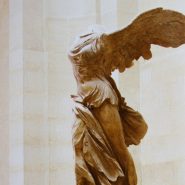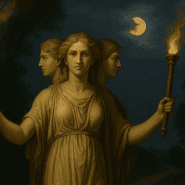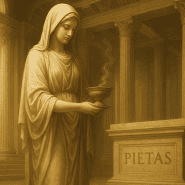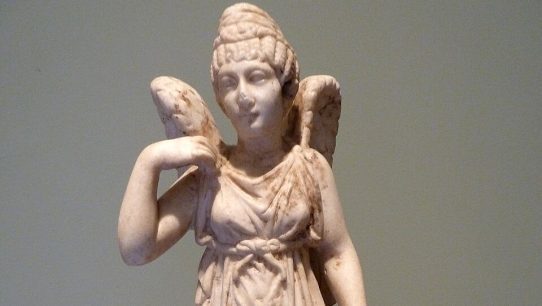Nemesis, the spirit of retribution and balance, was the divine force that punished arrogance, injustice, and excessive pride. To the Romans, she represented the moral equilibrium of the universe — the assurance that every action, good or evil, would eventually meet its rightful consequence. While her origins were Greek, the Romans revered Nemesis as a personification of divine justice, an impartial power who restored order where human ambition threatened harmony.
Origins and Mythological Background
The name Nemesis derives from the Greek verb nemein, meaning “to give what is due.” In both Greek and Roman thought, Nemesis was not merely a goddess of vengeance but of moral proportion — she ensured that fortune and punishment were distributed fairly, maintaining cosmic balance.
The Romans adopted her cult as an extension of their own moral code, which valued moderation (temperantia) and justice (iustitia). In this worldview, Nemesis stood against hubris — the human tendency to overstep divine or natural limits. Those who grew too fortunate or proud invited her retribution, for Nemesis despised imbalance above all else.
In some traditions, Nemesis was said to be the daughter of Nyx (Night), born from the darkness that guards the world’s secrets. Others described her as a daughter of Oceanus, linking her to the endless ebb and flow of fate. Regardless of origin, she remained a constant reminder that no power, mortal or divine, could escape accountability.
Attributes and Symbols
Nemesis was often portrayed as a winged woman, her expression solemn and unyielding. In her hands, she might hold a sword or scourge to execute punishment, a set of scales to weigh deeds, and a wheel or bridle to symbolize restraint and the changing turns of fate.
Sometimes she was depicted with a measuring rod, emphasizing her role in meting out justice precisely — no more, no less. Her wings suggested that justice, though slow in mortal reckoning, would always arrive. The image of the wheel, like that of Fortuna’s, served as a warning that fortune’s height is precarious and temporary.
Temples and altars to Nemesis often stood near theaters, arenas, and racecourses. There, she presided over contests of skill and ambition, ensuring that victory came to the deserving and punishing deceit or excessive pride. The Romans invoked her before battle and games alike, seeking a fair outcome guided by divine measure.
Worship and Cult
One of the most renowned centers of Nemesis’s worship was at Rhamnous in Greece, where a grand marble statue by Agoracritos — a pupil of Phidias — portrayed her with a crown of deer and small images of Nike, the goddess of victory. The Romans later embraced her worship as Nemesis Campestris (Nemesis of the Fields), particularly among soldiers.
Roman legions built shrines to her across the empire, venerating her as a protector of discipline and fairness in war. In these contexts, Nemesis was not a vengeful deity but a guarantor of justice — ensuring that honor and punishment were deserved.
The Romans also connected her with Fortuna and the Fates (Parcae), integrating her into a network of deities who governed destiny. Together, they reinforced the Roman ideal that success and suffering must be earned in proportion to merit.
Nemesis in Literature and Thought
Roman poets and philosophers frequently invoked Nemesis as a warning against arrogance. Ovid described her as a silent avenger who pursued Narcissus after he scorned others out of vanity, turning his self-love into his ruin. In this tale, Nemesis becomes the mirror of conscience — a moral force disguised as fate.
Horace and Juvenal used her name metaphorically to remind Rome’s elite that power unchecked would summon its own downfall. To the Stoics, Nemesis embodied the rational order of the cosmos: a principle ensuring that imbalance, whether moral or material, could not endure.
The Duality of Justice
Nemesis embodied a paradox — mercy through punishment. Her justice was not born of cruelty but necessity, restoring harmony where excess reigned. She punished the wicked not for pleasure but for correction, and she humbled the fortunate so that gratitude, not arrogance, might prevail.
In some representations, she appeared alongside Aidos, the spirit of modesty, symbolizing that reverence and restraint were humanity’s safeguards against divine retribution. Thus, Nemesis was both feared and respected: an unrelenting reminder that balance sustains the world.
Legacy and Influence
As Roman civilization gave way to the Christian era, Nemesis’s image transformed into the broader concept of divine justice. Her symbols — the scales, the sword, and the blindfold — evolved into modern depictions of Lady Justice, still seen in courts and civic monuments today.
In art and philosophy, Nemesis continues to represent the moral rhythm of existence: every rise invites a fall, every excess demands restoration. Her legacy endures not as vengeance, but as balance — the eternal law that no act escapes consequence.








